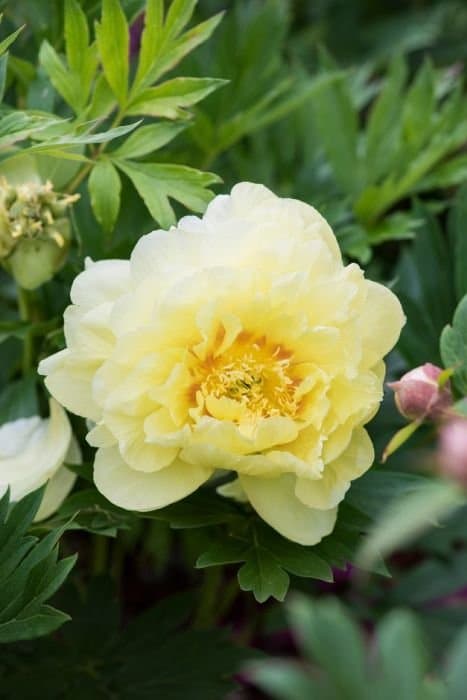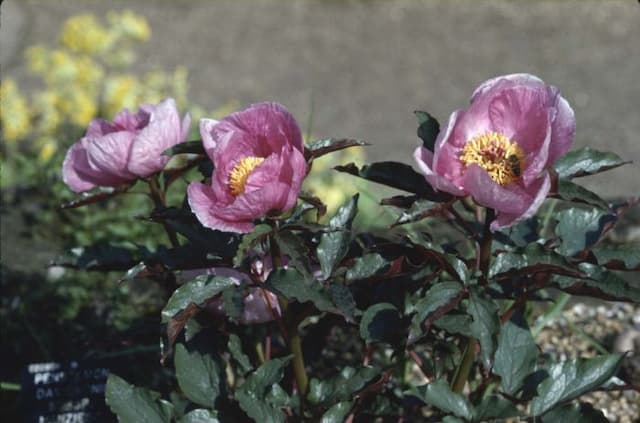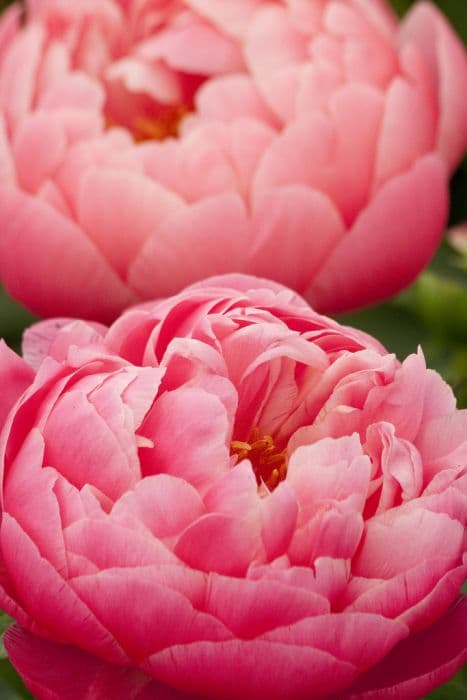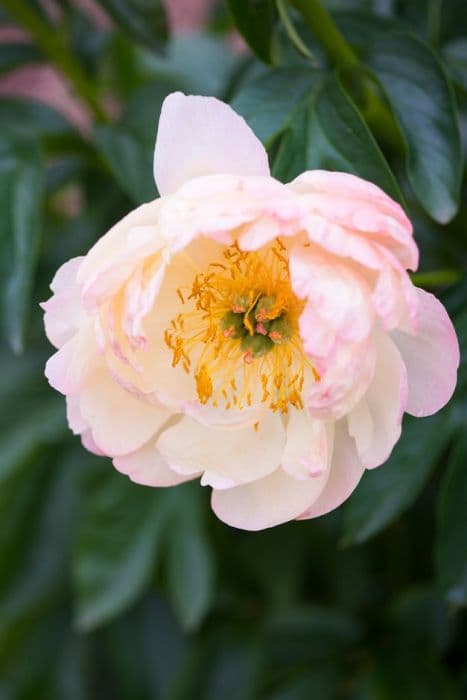Peony Paeonia 'Magical Mystery Tour'

ABOUT
The Paeonia 'Magical Mystery Tour', commonly called a peony, is an ornamental flowering plant known for its stunning and large blossoms which can be a spectacular addition to any garden. This plant showcases plush, fully double flowers that exhibit a blend of creamy yellow petals interspersed with soft pink blushes and highlights. The peony's mesmerizing flowers are further accentuated by their beautifully arranged, layered petals which often boast a slightly ruffled texture, giving them a lush, full appearance. The center of the blooms may reveal a hint of deeper pink tones, giving the overall flower a sense of depth and complexity. Surrounding the showy blooms, the plant has lush, deep green foliage that provides a striking contrast to the soft hues of the flowers. The leaves are divided and have an almost leathery feel with a lustrous surface that catches the light. These leaves typically grow in a complementary, mounded form that encircles the stems and creates an attractive, dense green backdrop throughout the growing season. As the plant transitions through its growth cycle, the leaves may also exhibit touches of bronze or red, adding to its seasonal interest. The peony 'Magical Mystery Tour' not only delights with its visual beauty but may also emit a pleasant fragrance, contributing a subtle and sweet aroma to its surroundings. Its sensory appeal and romantic, billowy blossoms make it a favorite for cut flower arrangements and a charming addition to perennial borders or as a focal point in garden designs where its aesthetic qualities can be thoroughly appreciated.
About this plant
 Names
NamesFamily
Paeoniaceae
Synonyms
Peony, Garden Peony
Common names
Paeonia 'Magical Mystery Tour'.
 Toxicity
ToxicityTo humans
The Paeonia 'Magical Mystery Tour', commonly known as the peony, is generally not considered highly toxic to humans. However, peonies contain a compound called paeonol, which can cause mild gastrointestinal upset if ingested in large quantities. Symptoms of peony ingestion can include nausea, vomiting, and diarrhea. While accidental ingestion of small amounts of peony parts is unlikely to cause severe poisoning, it is advised to avoid consuming this plant, and to keep it out of reach of children who might be tempted by its attractive flowers.
To pets
Peonies, including the Paeonia 'Magical Mystery Tour' variety, are considered to be mildly toxic to pets. If pets, such as dogs and cats, ingest parts of the peony, they may experience symptoms such as vomiting, diarrhea, and drooling. In some cases, the peony may also cause mild depression in pets. While toxicity is generally low, it is nonetheless wise to prevent pets from ingesting this plant to avoid any potential adverse effects.
 Characteristics
CharacteristicsLife cycle
Perennials
Foliage type
Deciduous
Color of leaves
Green
Flower color
Mixed
Height
2-3 feet (0.6-0.9 meters)
Spread
2-3 feet (0.6-0.9 meters)
Plant type
Herbaceous
Hardiness zones
3-8
Native area
Asia
Benefits
 General Benefits
General Benefits- Aesthetic Appeal: Paeonia 'Magical Mystery Tour', commonly known as peony, offers large, showy flowers that are highly decorative and appealing to many gardeners.
- Versatility in Landscaping: Peonies are versatile and can be used in borders, as focal points, or in floral arrangements to enhance the beauty of gardens and homes.
- Longevity: Peonies are known for their ability to live and bloom for decades, often outliving the gardeners who plant them, making them a long-term investment for any garden.
- Attracts Pollinators: The blooms of peonies attract bees and other pollinators, which are essential for the pollination of many other plants and for maintaining healthy gardens and ecosystems.
- Low Maintenance: Once established, peonies require relatively little care beyond occasional watering and pruning, making them suitable for gardeners of all skill levels.
- Cold Hardiness: Peonies are capable of withstanding cold temperatures, making them suitable for gardens in cooler climates where other flowers might not thrive.
- Drought Tolerance: After getting established, peonies have a tolerance for short periods of drought, which makes them suitable for gardens in regions with less consistent rainfall.
- Deer Resistant: Peonies are generally resistant to deer, which means that they are less likely to be damaged by deer browsing compared to many other garden plants.
 Medical Properties
Medical PropertiesThis plant is not used for medical purposes.
 Air-purifying Qualities
Air-purifying QualitiesThis plant is not specifically known for air purifying qualities.
 Other Uses
Other Uses- Paeonia, commonly known as peony, petals can be used as a natural fabric dye, giving textiles a soft pink to purple hue, depending on the concentration.
- Dried peony petals can serve as a decorative addition to homemade soaps and candles, infusing them with a floral fragrance and aesthetic appeal.
- The sturdy stems of peony plants are often repurposed in the garden as support for other, more delicate flowering plants that might otherwise droop or fall over.
- Peony petals can be pressed and used in crafting, such as for making bookmarks, greeting cards, or in scrapbooking to add natural beauty to the artwork.
- The peony's large, lush blooms make excellent natural bowls for floating candles or other decorative centerpiece elements at special events.
- After the blooming season, peony seed pods can be dried and incorporated into autumn-themed wreaths or as part of a dried flower arrangement.
- Fallen peony petals can be collected and placed in drawers or closets to serve as a natural fragrance enhancer for linens and clothing.
- The peony's voluminous flowers are used in culinary presentations, particularly in high-end restaurants, as an edible garnish that adds elegance to dishes and desserts.
- Artists might use peony plants as a subject for photography, painting, or drawing studies, capturing their lush, intricate forms and vibrant colors.
- Crafted peony flowers made from tissues or crepe paper can be used as a sustainable alternative to fresh cut flowers for decorative purposes.
Interesting Facts
 Feng Shui
Feng ShuiThe Peony is not used in Feng Shui practice.
 Zodiac Sign Compitability
Zodiac Sign CompitabilityThe Peony is not used in astrology practice.
 Plant Symbolism
Plant Symbolism- Prosperity: Peonies are often associated with wealth and honor, symbolizing an abundance of blessings and material well-being.
- Romance: The lush, full blooms of peonies represent love and affection, making them a popular choice in wedding arrangements and romantic bouquets.
- Beauty in all forms: Known for their stunning petals and elegant appearance, peonies symbolize the ideal of beauty in various aspects, from physical to emotional.
- Good fortune and happiness: In many cultures, peonies signify luck and joy, often presented as a positive omen for a happy life.
- Compassion: Peonies can symbolize compassion and empathy, a reminder of our connection with others and the kindness we share.
- Healing: Historically, peonies have been used for their medicinal properties, representing healing and the alleviation of pain.
 Water
WaterPeonies, including the 'Magical Mystery Tour', should be watered deeply once a week, providing about one inch of water each time. In general, this translates to around 0.623 gallons per square foot per week. It's crucial to avoid overhead watering to prevent fungal diseases, so direct the water at the base of the plant. During periods of drought or extreme heat, you may need to water more frequently while ensuring the soil drains well and doesn't become waterlogged. During the fall, you can reduce watering as the plant prepares for dormancy.
 Light
LightPeonies like 'Magical Mystery Tour' thrive best in full sun, getting at least six hours of direct sunlight daily. An ideal spot would be in a garden area that receives morning sunlight and some partial shade during the hottest part of the afternoon. Avoid deep shade locations as it may hinder bloom and make the plant vulnerable to disease.
 Temperature
TemperaturePeonies, including 'Magical Mystery Tour', prefer temperate climates and do well in temperatures that fluctuate seasonally. They can survive winter temperatures down to around -20°F and are heat tolerant up to about 90°F. The ideal growing temperature for these peonies is between 65°F and 75°F during their growth and bloom period in the spring.
 Pruning
PruningPrune 'Magical Mystery Tour' peonies in the fall after the leaves have died back completely to avoid disease and prepare the plant for winter. Cut the stems down to about two to three inches above the ground. Doing so once a year helps maintain plant health and promotes better blooms the following season. The best time for pruning is late autumn after the first frost.
 Cleaning
CleaningAs needed
 Soil
SoilPeonies like Paeonia 'Magical Mystery Tour' thrive best in well-draining soil with a pH of 6.0 to 7.0. A good mixture for these peonies is one-part topsoil, one-part compost, and one-part perlite or coarse sand to ensure proper drainage. Adding organic matter annually will keep the soil fertile and help maintain the necessary pH balance.
 Repotting
RepottingPeonies like Paeonia 'Magical Mystery Tour' don't need frequent repotting and prefer to be left undisturbed. It's typically unnecessary to repot peonies unless they are being divided to propagate new plants. Otherwise, peonies can stay in the same spot for many years without the need for repotting.
 Humidity & Misting
Humidity & MistingPeonies such as Paeonia 'Magical Mystery Tour' are not particularly sensitive to humidity and can thrive in average outdoor humidity levels. They do well in the varying humidity levels typically found in temperate regions outdoor garden settings.
 Suitable locations
Suitable locationsIndoor
Peonies like Paeonia 'Magical Mystery Tour' rarely thrive indoors; need full sun, cool temps.
Outdoor
Plant in sun to part-shade, fertile soil, water regularly in growing season.
Hardiness zone
3-8 USDA
 Life cycle
Life cycleThe peony 'Magical Mystery Tour' begins its lifecycle with the germination of seeds or the growth of new shoots from rhizomes. In spring, it develops stems and deeply lobed leaves, followed by the budding of conspicuous flowers, which bloom in late spring to early summer, showcasing their distinctive coloration and form. After pollination, often by insects attracted to the blooms, the flowers develop into seed pods. By late summer or fall, the seed pods mature and release seeds, while the above-ground plant parts begin to yellow and die back as the plant enters dormancy. The peony's roots survive the winter underground, in a period of rest and energy conservation. With the return of warmer weather, the cycle recommences with the emergence of new shoots, repeating the annual growth cycle.
 Propogation
PropogationPropogation time
Spring-Early Summer
For the Paeonia 'Magical Mystery Tour', commonly known as peony, division is the most popular method of propagation. This is typically done in the fall, after the plant has become dormant. To propagate by division, one should carefully lift the entire peony clump from the ground and gently shake or wash off the soil to reveal the root structure. Using a sharp knife, divide the clump into smaller sections, ensuring each section has at least three to five eyes, which are the growth nodes where next year's shoots will emerge. These divisions can be immediately replanted in well-drained soil at a depth where the eyes are positioned approximately 1-2 inches (2.5-5 cm) below the ground level. Water the newly planted divisions thoroughly to help establish them. This method allows gardeners to expand their collection of peonies or share them with others while ensuring the health and vitality of the plant.









